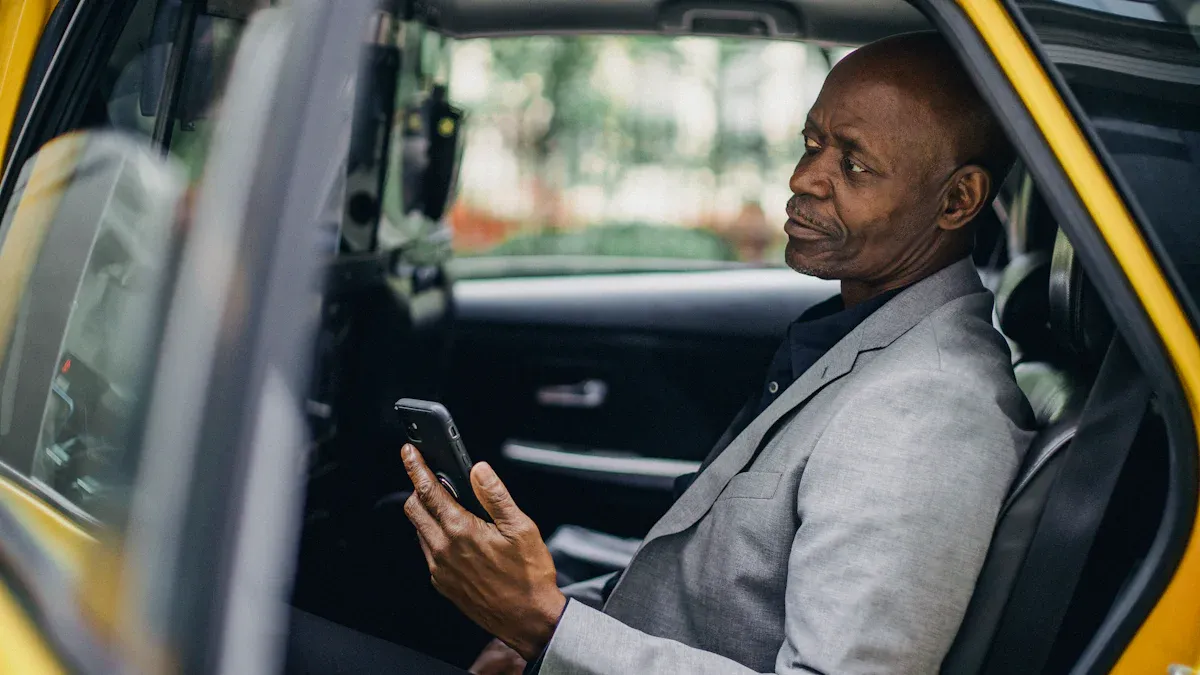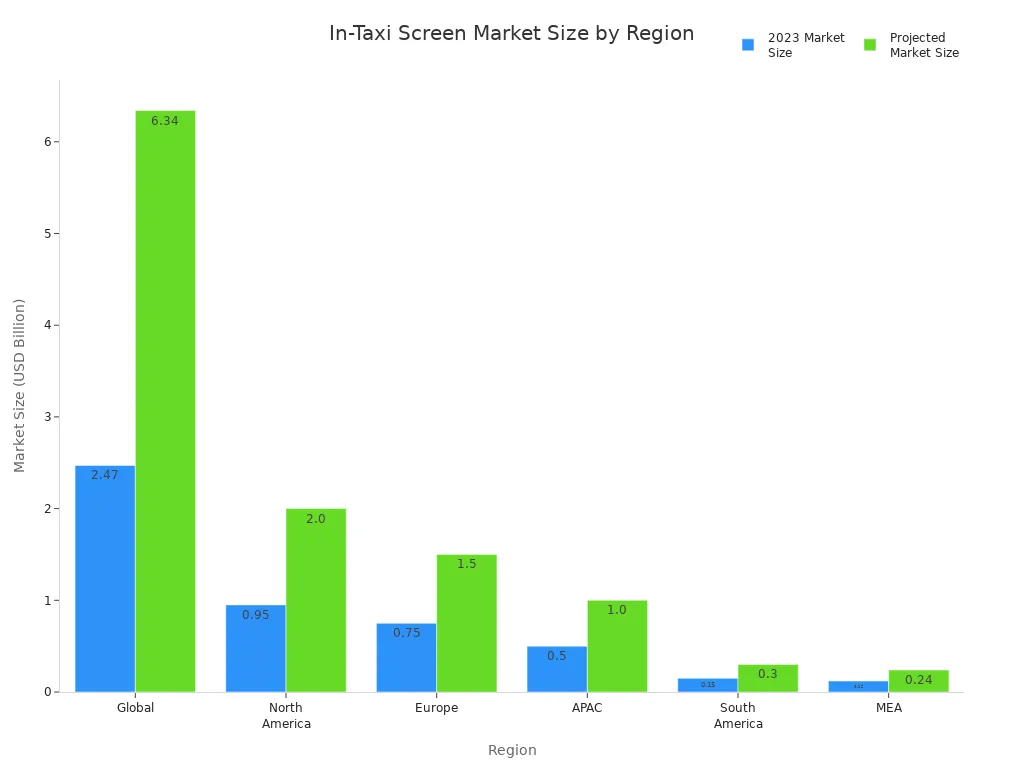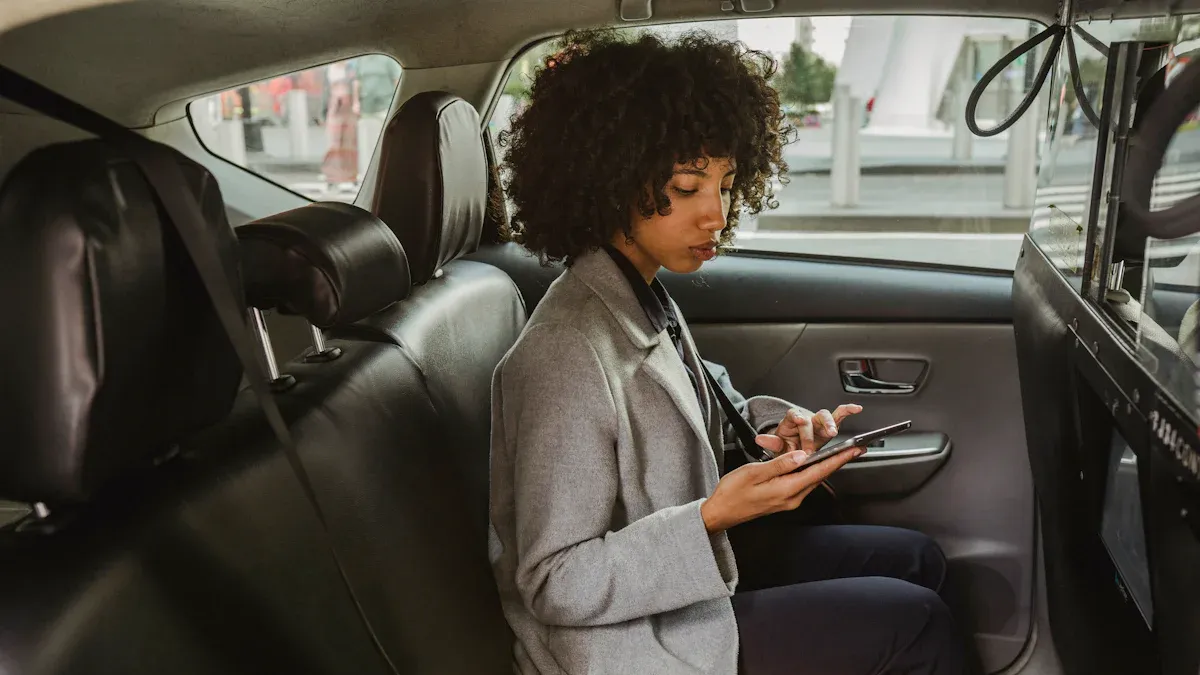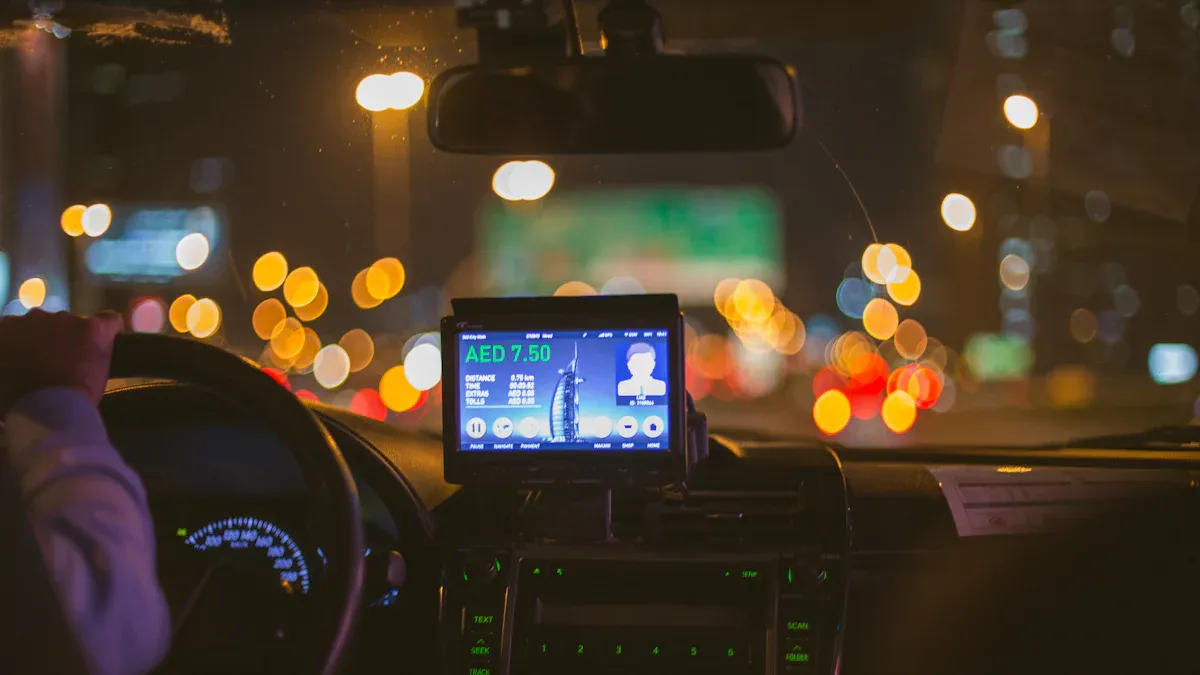
In-taxi promotional screens are digital displays inside taxis. They show ads and information while you ride. You can find these screens in regular taxis and ride-hailing cars. The screens use LCD or LED technology for bright pictures. Their main job is to show ads that fit your location or what you like. This makes the ads more useful to you. The global market for these screens has grown fast. It reached $2.47 billion in 2023. Big cities like New York, London, and Tokyo are leading this trend.

Key Takeaways
In-taxi promotional screens have bright LED or LCD displays. They show ads and local info inside taxis. This makes rides more fun and helpful. These screens use GPS and real-time updates. They show ads that fit your location and time. This helps advertisers reach the right people with new content. Passengers can use the screens by scanning QR codes. They can play games or check maps too. This makes taxi rides more fun and interesting. Advertisers get targeted ads and lots of people see them. It costs less than old types of ads. It is easy to track how well the ads work. The screens are made to last in bad weather. They save energy with LED technology. They give eco-friendly ads that help keep cities clean.
In-taxi Promotional Screens

Digital Display Technology
When you get into a taxi in New York City, you might see a bright screen in front of you. These in-taxi promotional screens use special display technology to show ads and information. Most taxi advertising uses LED or LCD screens. LED displays, like high-brightness SMD LED modules, are easy to see even in sunlight. They can last up to 15 years and use less energy than LCDs. You often see LED screens on top of taxis. These screens face rain, dust, and strong sunlight. Their covers protect them from bad weather.
Inside the taxi, LCD monitors show clear pictures with high detail. They work best inside the car, where it is not too bright. LCDs cost less at first, but they do not last as long as LEDs. LCDs also use more power. LED screens have better colors and you can see them from more angles. This makes your ride look more interesting. Taxi top screens use the car’s battery and can show ads all day and night. You see these digital signage displays all over New York City. Taxi advertising is a big part of the city’s busy ad scene.
Tip: LED screens on taxi tops can change ads right away using 4G. This means you always see the newest promotions.
Interactive Features
In-taxi promotional screens do more than just show ads. They let you interact with what you see. Many screens show QR codes you can scan with your phone. When you scan a code, you can get discounts, visit online shops, or join special deals. These QR codes make taxi advertising more powerful. You become part of the ad, not just someone watching.
Some screens use GPS to show ads for places near you. For example, if you ride through Times Square, you might see ads for local restaurants or events. Remote control features, like Wi-Fi and 4G, help companies change ads fast. Light sensors make the screen brighter or dimmer, so you always see clearly. These interactive features make digital signage in taxis more fun and useful for you.
Scan QR codes to get deals and special offers.
See ads that match where you are in New York City.
Enjoy content that changes quickly for a new experience.
Content Formats
You see many kinds of content on in-taxi promotional screens. Digital video ads play short, colorful clips to catch your eye. Sometimes, audio ads play with the video to make the message stronger. Some screens let you play games or take quizzes to keep you busy during your ride.
Taxi top screens often show still images, moving videos, or short messages. These digital signage displays can switch ads, so you see something new every few seconds. Inside the taxi, you might see ads on headrests, windows, or small screens on the seats. These formats work well because you spend 10 to 30 minutes in the taxi. This gives you time to notice and remember the ads.
Interactive games and QR codes
Animated and still images on taxi top screens
Real-time updates for new promotions
The type of content affects how well you remember the ad. Bright pictures and short taglines help brands stand out. Changing content lets advertisers show different messages based on time, weather, or place. This makes taxi advertising in New York City work better and helps brands connect with you in a personal way.
How They Work
GPS and Location Targeting
When you ride in a taxi in New York City, the promotional screens use GPS to find your location. The system inside the taxi gets GPS data all the time. This helps the screen show ads that fit where you are. For example, if your taxi goes by a famous restaurant or event, the screen can switch to an ad for that place. This is called location-based content. You see ads for businesses, attractions, or events close to you. The Navori GPS Trigger module works with the digital signage hardware to make this happen. It updates ads using Wi-Fi or cellular, so you always get new information.
This way of geo-targeting makes ads work better. You get ads that matter to you, and local businesses reach people nearby. When your taxi enters a certain area, the system notices and changes the ad for that spot. When you leave, the screen goes back to normal content. This real-time geo-targeting helps advertisers reach you at the right time. In New York City, you might see ads for a Broadway show in Times Square or a coffee shop near Central Park.
Note: GPS-based targeting makes sure you see ads for places and events near you, making your ride more fun and helpful.
Programmatic Ad Delivery
Programmatic ad delivery changes how ads work inside taxis in New York City. Advertisers use special software called demand-side platforms (DSPs) to pick which ads to show and when. These platforms let advertisers set rules for their campaigns, like which neighborhoods to target or what time to show certain ads. The system sends these ads wirelessly to the taxi screens. You see ads that match your location, the time, and sometimes your interests.
This process uses geo-targeted ads, dayparting, and audience filters. Geo-targeted ads make sure you see promotions that fit your area in New York City. Dayparting means the system can show breakfast ads in the morning and dinner ads at night. Audience filters help match ads to the type of people riding in the taxi. The screens collect data and send it back to advertisers, so they know which ads work best.
Here are some main advantages of programmatic ad buying for in-taxi advertising:
Precision targeting lets advertisers reach people based on age, interests, and location.
Real-time optimization allows instant changes to campaigns if something is not working.
Cost-effectiveness comes from paying only for ads that reach the right people.
Transparency and analytics give advertisers clear reports on how their ads perform.
The process is fast and easy, with no need for manual deals or printing.
In New York City, programmatic ad delivery helps brands reach many different people as taxis move through neighborhoods. Taxis travel all over, so your ad can show up in many parts of the city in one day.
Real-time Updates
Real-time updates keep the ads on in-taxi screens new and useful. The system uses remote control technology, so advertisers can change ads quickly without going to each taxi. You always see the latest promotions, like a new store opening or a special event in New York City. AI algorithms help check what passengers like and change the ads to fit their interests.
Taxi LED screens update content in real time. This means you see ads that match the weather, holidays, or even traffic. For example, if it starts to rain in New York City, the screen might show an ad for umbrellas or raincoats. The system can also change ads based on the time of day or the neighborhood you are in. This makes advertising work better than old billboards.
Here are some benefits of real-time updates for advertisers:
Remote control and instant changes save time and money.
Advertisers can respond quickly to market trends or local events.
Dynamic content display helps target the right audience at the right time.
Real-time updates allow ads to follow you through the city, giving you timely information during your ride.
No need for printing or manual installation, which lowers costs.
Tip: Real-time updates make sure you always see ads that matter, whether you live in New York City or are just visiting.
Benefits for Advertisers
Targeted Taxi Advertising
In-taxi promotional screens help you reach the right people. You can show ads to certain groups based on who is riding. The screens know where the taxi is and can change ads for that spot. For example, if the taxi is near a gym, you can show a gym ad. If it is in a busy food area, you can show restaurant ads. This is better than old in-car ads. You can also change your ads fast to keep them fresh. Studies show this makes people notice and remember your brand more. Fun features like games or surveys make ads stand out. Taxi advertising lets you reach many people and also target local spots.
Pick busy roads and popular places for more views.
Use games or quizzes to get people to join in.
Enhanced Exposure
Taxi ads help more people see your brand. Taxis drive all over the city, so your ads go everywhere. Taxi roof screens with LED lights are easy to see, even at night. Your ads stay up all day and night, so more people notice them. Bright pictures and moving ads catch people’s eyes. People in taxis look at these screens longer than other ads. This helps them remember your brand better. Taxi TV keeps people’s attention because they are inside the car.
Note: Taxi roof ads let you reach people walking, driving, or riding buses, so your brand gets seen by many.
Cost-effectiveness
Taxi ads cost less than TV or big billboards. You can reach lots of city people for less money. You can check how your ads are doing right away with data. This helps you spend your money better and get more for it. You can change your ads by place or time to make them work better. QR codes or promo codes help you see if people use your ads.
Lower cost than other types of ads.
Change who sees your ads for better results.
In-taxi promotional screens are a smart way for brands to reach the right people, get noticed more, and save money.
Benefits for Passengers
Infotainment and Engagement
When you ride in a taxi with a digital screen, you get more than ads. The screens make your trip fun and interesting. You can touch the screen to see city maps or check events. Some screens show you cool facts about places you pass. This helps you learn about the city and enjoy your ride.
You can use maps to find your way.
Event updates help you know what is happening.
Restaurant tips and stories make the ride better.
You can also watch short videos or play games. Some screens let you scan QR codes for deals. These things make the ride feel faster. Many people say these features make their trip better. When you have something to do, you enjoy the ride more. Taxi TV and changing content keep you interested. Every trip feels different.
Passengers often say infotainment helps them find new places and have more fun in the taxi. This makes people like taxi rides more and gives good feedback to taxi companies.
Relevant Local Content
In-taxi promotional screens show you things that match where you are. You see news, weather, and public messages for your area. The screens also show ads for stores, events, and fun places nearby. The content changes as you move through the city.
News and weather updates for right now
Ads for local stores and places
Public info like rules and street news
Fun things like movies and TV shows
These features make the content feel special and up-to-date. GPS helps the screen show you things that matter in your area. This makes you pay more attention because it is useful. People like seeing local info and feel more connected to the city. The screens work all day, so you always see new and helpful content.
Technical Features

Durability and Eco-friendliness
When you ride in a taxi, you might see screens inside. These screens are made to last in tough city life. They use strong materials and smart designs. The screens work in very cold or hot weather. They can handle temperatures from freezing to really hot days. Special power supplies and heat devices help them work from -40°C to 60°C.
You do not need to worry about rain or dust. The screens have high protection, like IP65 or IP66. This means water and dust cannot get inside. The outside shell is made of aluminum. It has coatings that stop rust and block the sun’s rays. This keeps the screens safe from getting old or damaged. The screen has a frosted PC plate. This stops it from turning yellow or wearing out. Inside, the power supply is protected. It stops problems like too much power or short circuits. The screens are shockproof, so bumps and shakes do not break them. They are easy to fix and quick to install. This means they keep working with little downtime.
Here is a table with some main features:
Feature Category | Technical Feature Description |
|---|---|
Temperature Tolerance | Works from -40°C to 60°C with special power and heat control. |
Waterproof & Dustproof | IP65/IP66 keeps out water and dust. |
Material Durability | Aluminum shell with coatings to stop rust and sun damage. |
Screen Protection | Frosted PC plate keeps the screen from yellowing or aging. |
Power Supply Protection | Stops problems like too much power or short circuits. |
Shock Resistance | Shockproof design helps with bumpy rides. |
Maintenance & Installation | Easy to fix and quick to put in. |
You also help the planet by using taxis with digital signage. These screens use LED lights that save energy. This means they use less power and make less pollution. Smart circuits and energy-saving ICs help save the car battery. Many screens use acrylic or other eco-friendly materials. This keeps the display clear and helps the environment. LED screens last a long time, so there is less waste. Smart systems help save even more energy.
Tip: Riding in taxis with digital signage helps keep cities clean and cuts down on waste.
In-taxi promotional screens give you a unique way to reach people during their ride. You see bright videos, interactive ads, and real-time updates that make your trip more enjoyable. Advertisers can target messages by location and time, which boosts brand recall and engagement.
You get entertainment and local info right in your seat.
Advertisers enjoy dynamic, data-driven campaigns with strong ROI and future growth.
Pick the right format and design bold, simple ads.
Track results and adjust for better impact.
In-taxi screens stand out as a smart, modern choice for both brands and passengers.
FAQ
How do in-taxi promotional screens know which ads to show?
GPS technology helps the screens know your location. The system uses this data to show ads for nearby stores, events, or services. You see content that matches where you are in the city.
Can you interact with the screen during your ride?
Yes, you can. Many screens let you scan QR codes, play games, or answer surveys. You get deals or information by interacting with the screen.
Are the screens distracting for drivers or passengers?
No, the screens face passengers and use safe brightness levels. Drivers do not see the screens while driving. You can adjust the volume or brightness if needed.
Do in-taxi screens collect your personal data?
The screens do not collect your personal details. They use general data like location or time. Your privacy stays protected during your ride.
Tip: If you have privacy concerns, ask your driver or check the screen’s info page for more details.
See Also
Best Five CarPlay Screens For E90 Models Under Budget
Audi CarPlay Screens Inspired By Tesla Compared By Price
Best CarPlay To HDMI Adapters For 4K Streaming 2025
Top CarPlay Dongles That Support Netflix Reviewed And Rated
Budget Friendly Portable CarPlay Devices Suitable For All Drivers
